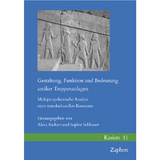Gestaltung, Funktion und Bedeutung antiker Treppenanlagen
Multiperspektivische Analyse einer transkulturellen Konstante
Seiten
Im Rahmen eines Symposiums wurde die Annäherung an einen kulturimmanenten Blickwinkel auf antike Architektur anhand des Fallbeispiels „Treppenanlagen“ erprobt. Im Anschluss an einer Einführung in das Konzept und den Forschungszweig der Scalalogie versammelt der aus dem Symposium hervorgegangene Band 18 Beiträge zu Treppen im Alten Orient, im Alten Ägypten, in der griechischen und in der römischen Welt und in der Spätantike. Die Treppe hat seit ihrer frühesten belegbaren Nutzung in prähistorischer Zeit ihre architektonische und soziale Bedeutung trotz der vermehrten Verwendung technischer Hilfsmittel nie eingebüßt. Es handelt sich um ein architektonisches Element, auf welches Menschen auf der ganzen Welt täglich angewiesen sind und das zudem bis heute als Symbol- und Bedeutungsträger verstanden wird. Dementsprechend besitzen Treppen eine enorme Aussagekraft hinsichtlich kulturimmanenter Entwicklungen von Architektursymboliken sowie kulturübergreifender Deutungsprinzipien und sind somit ein Forschungsgegenstand von nur scheinbarer Marginalität. Die Studien widmen sich unter anderem den Treppen und Treppenhäusern in den Tempeln von Tell al-‘Ubayd, Khafajah und Eridu, im Königspalast von Qaṭna und im Roten Haus in Dūr-Katlimmu im Alten Orient, im Horustempel von Edfu und im Hathortempel von Dendara im Alten Ägypten, im minoischen Palast von Phaistos, verborgenen Treppen in antiken griechischen Tempeln und den Treppenanlagen in Vitruvius De Architectura und in spätantiken Pilgerzentren in Asia Minor. As part of a symposium, the approach to a culture-immanent perspective on ancient architecture was tested using the case study of "staircases". Following an introduction to the concept and research branch of Scalalogy, the volume that emerged from the symposium brings together 18 contributions to staircases in the Ancient Near East, Ancient Egypt, the Greek and Roman worlds and late antiquity. Since its earliest proven use in prehistoric times, the staircase has never lost its architectural and social importance, despite the increased use of technical aids. It is an architectural element that people all over the world depend on every day and which is also understood to this day as a symbol and carrier of meaning. Correspondingly, stairs have an enormous expressiveness with regard to culturally immanent developments of architectural symbols as well as cross-cultural principles of interpretation and are therefore a research object of only apparent marginality. The studies are devoted, inter alia, to staircases and stairwells in the temples of Tell al-'Ubayd, Khafajah and Eridu, in the royal palace of Qaṭna and in the Red House in Dūr-Katlimmu in the Ancient Near East, in the Temple of Horus at Edfu and in the Temple of Hathor at Dendara in Ancient Egypt, in the Minoan palace of Phaistos, hidden stairways in ancient Greek temples and the stairways in Vitruvius’ De Architectura, and in late antique pilgrimage centers in Asia Minor.
| Erscheinungsdatum | 15.05.2023 |
|---|---|
| Reihe/Serie | Kasion ; 11 |
| Verlagsort | Münster |
| Sprache | englisch; französisch; deutsch |
| Maße | 170 x 240 mm |
| Gewicht | 1100 g |
| Themenwelt | Geisteswissenschaften ► Archäologie |
| Technik ► Architektur | |
| Schlagworte | Antike • Scalalogie • Treppen |
| ISBN-10 | 3-96327-214-7 / 3963272147 |
| ISBN-13 | 978-3-96327-214-1 / 9783963272141 |
| Zustand | Neuware |
| Informationen gemäß Produktsicherheitsverordnung (GPSR) | |
| Haben Sie eine Frage zum Produkt? |
Mehr entdecken
aus dem Bereich
aus dem Bereich
maternal health science and the reproduction of harm
Buch | Softcover (2024)
University of California Press (Verlag)
37,40 €
Holocaust heritage, noncitizen futures, and black power in Berlin
Buch | Softcover (2022)
University of California Press (Verlag)
37,40 €




